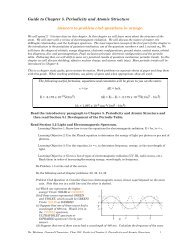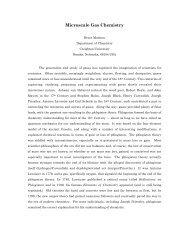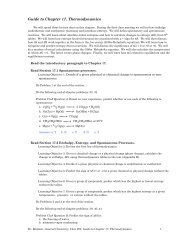Other Microscale Gas Methods - Mattson - Creighton University
Other Microscale Gas Methods - Mattson - Creighton University
Other Microscale Gas Methods - Mattson - Creighton University
You also want an ePaper? Increase the reach of your titles
YUMPU automatically turns print PDFs into web optimized ePapers that Google loves.
<strong>Microscale</strong> <strong>Gas</strong> Chemistry<br />
Supplement: <strong>Other</strong> <strong>Microscale</strong> <strong>Gas</strong> <strong>Methods</strong><br />
Bruce <strong>Mattson</strong><br />
Department of Chemistry<br />
<strong>Creighton</strong> <strong>University</strong><br />
Omaha, Nebraska, 68104 USA<br />
The in-syringe method first proposed by Hubert Alyea and extensively developed by<br />
our group is by no means the only microscale gas chemistry technique. A variety of other<br />
microscale gas chemistry methods are currently in use and we summarize here those of<br />
which we are aware. <strong>Other</strong> such methods will be added to this list as we become aware of<br />
them.<br />
Viktor Obendrauf (Austria) has developed numerous methods of gas generation using<br />
10-20 mL syringes, small test tubes, soft latex stoppers or septa and blunt needles similar to<br />
that proposed by Alyea. His refinements include the use of a reagent syringe (Figure 1).<br />
Much of his work with microscale gas chemistry (methods and numerous interesting<br />
experiments) has appeared in German-language journals such as Chemie & Schule<br />
(Salzburg) but a good overview of his methods can be found in his web-based article in<br />
Chemical Education Journal [Obendrauf, 2002]. Among many ingenious features, Obendrauf<br />
uses a syringe packed with charcoal to absorb unwanted gases as they continue to generate<br />
in the reaction test tube. Obendrauf’s methods using medical apparatuses (septa, needles,<br />
etc.) for the generation of gases have led to various companies marketing the necessary<br />
equipment for European markets [Menzel, web].<br />
1
Figure 1. Viktor Obendrauf uses a small test tube containing a solid reagent with the second<br />
reagent in a small syringe; the large syringe is the gas receiving syringe [Obendrauf, 2002].<br />
Alan Slater and Geoff Rayner-Canham generate gases in one cell of a 24-well plate<br />
and collect the gas in pipet bulbs (Figure 2) [Slater, 1994].<br />
Figure 2. Slater and Rayner-Canham describe the generation of gases in a 24-well plate.<br />
An ingeniously small-scale, inexpensive apparatus is described by Lise Kvittingen<br />
and Richard Verley (Norway) in which the reaction vessel is a centrifuge tube and the<br />
dropping funnel is a thin-stem pipet. The gas collection vessel is a wide-stem pipet and used<br />
the method of water displacement (Figure 3) [Kvittingen, 2004].<br />
2
Figure 3. Kvittingen and Verley’s apparatus is similar in principle to the traditional 19 th<br />
Century equipment — only 100 times smaller.<br />
Certain gases are readily produced by electrochemical methods and microscale<br />
methods for generating gases this way using pipet bulbs have also appeared. Per-Odd Eggen<br />
and Lise Kvittingen have described the electrolysis of water using one or two pipet bulbs as<br />
shown in Figure 4 [Eggen, 2004].<br />
Figure 4. Electrochemical method for the generation of gases using a pipet bulb and a 9-volt<br />
battery.<br />
Ozone is also conveniently produced by an electrochemical method as described by<br />
Jorge Ibáñez and Bruce <strong>Mattson</strong> and shown in Figure 5. This method is well-suited for use<br />
of gases in situ [Ibáñez, 2005a].<br />
3
Figure 5. Electrochemical generation of ozone in a pipet bulb.<br />
Generation of chlorine dioxide for in situ use has also been described by Ibáñez,<br />
Anderson and <strong>Mattson</strong>. The device which uses a Beral pipet as the generation chamber is<br />
shown in Figure 6. This method could be extended for use with a wide variety of gases. In<br />
this and the previous example, the stem of a Barel pipet has been stretched to 30 cm or more<br />
in length so that the gas can be conveniently delivered to the desired destination [Ibáñez,<br />
2005b].<br />
Figure 6. Use of a pipet bulb to generate gas in situ — especially useful for gas samples that<br />
cannot be stored because they are unstable.<br />
<strong>Microscale</strong> gas chemistry need not involve expensive or expensive apparatus. Martin<br />
Choi describes making chlorine in a drop of solution in a Petri dish and allowing gas<br />
4
diffusion to carry the chlorine to various reagents present in other drops in the dish (Figure<br />
7) [Choi, 2002].<br />
Figure 7. <strong>Gas</strong> chemistry by diffusion. [Choi, 2002] Used with permission from the Journal of<br />
Chemical Education, copyright 2002, Division of Chemical Education, Inc.<br />
Using a test tube and Beral pipet with slits cut into the bulb, James Kilroy and Mary<br />
Virginia Orna describe the simple device pictured in Figure 8 in various attitudes. An<br />
especially nice feature is that one can stop gas generation at any time by lifting the reaction<br />
chamber out of the aqueous reagent [Kilroy, 1994].<br />
Figure 8. From left: A. Beral pipet with slits cut into the bulb; B. opening the slits to add solid<br />
reagent; C. pipet in contact with aqueous reagent and concomitant production of gas; D. pipet<br />
raised out of aqueous solution to stop gas generation<br />
5
The Kipp generator, described in the Brief History supplement at this website has<br />
inspired similar small-scale devices. A 20-mL gas capacity one-piece clear plastic Kipp<br />
generator, pictured in Figure 9 was invented in the former Federal Republic of Germany and<br />
popularized by Andreas Kometz and others [Kometz, 2001].<br />
Figure 9. A 20 mL Kipp generator standing next to a traditional 2.5 L model from the 19 th<br />
century<br />
From its inception, microscale methods have developed along two lines in terms of<br />
equipment sophistication and expense. Glass manufacturers have created ingeniously small<br />
apparatuses that tend to be expensive, while other methods tend to be inexpensive and use<br />
“consumable” plasticware. Figure 10, pictures an example of the former, a micro-Kipp<br />
generator about the size of a 250 mL beaker and described by Jinhua Wang [Wang 2003].<br />
The aqueous reagent is placed in the left reservoir and the solid reagent goes in the right<br />
reservoir where it rests on a sintered glass frit that separates it from the aqueous reagent.<br />
6
References:<br />
Figure 10. Another design of a microscale gas chemistry generator.<br />
Books and Special Publications:<br />
Kometz, A., Moderne Energietechnologien, Martin-Luther-Universitat, Halle-Wittenberg,<br />
Germany, 2001.<br />
Slater, A., Rayner-Canham, G., <strong>Microscale</strong> Chemistry Laboratory Manual; Addison-Wesley<br />
Publishers Limited, 1994.<br />
Electronic References:<br />
Menzel, P., “MedTech-Set LMP 1: Schülerversuche mit Medizintechnik-Zubehör: der<br />
einfache Umgang mit <strong>Gas</strong>en”, http://www.hedinger.de/schule/d_produkt_detail.asp?id=61,<br />
last electronic access 11 May 2005.<br />
Obendrauf, V., “Experimente mit <strong>Gas</strong>en im Minimastab”, Chemical Education Journal,<br />
http://chem.sci.utsunomiya-u.ac.jp/v7n2/angela/angela_abstract.html, last electronic access<br />
11 May 2005.<br />
Singh, M., Szafran, Z., Pike, R., “National <strong>Microscale</strong> Chemistry Center”,<br />
http://www.microscale.org/, last electronic access 11 May 2005.<br />
7
Journal Articles:<br />
Alyea, H. N., “Syringe <strong>Gas</strong> Generators,” Journal Chemical Education, 69 65 (1992)<br />
Choi, M., “<strong>Microscale</strong> Chemistry in a Plastic Petri Dish: Preparation and Chemical<br />
Properties of Chlorine <strong>Gas</strong>”, Journal Chemical Education,79, 992-993, 2002<br />
Eggen P. O.; and Kvittingen, L., “A Small-Scale and Low-Cost <strong>Gas</strong> Apparatus for the<br />
Electrolysis of Water”, Journal Chemical Education, 81, 1337-1338, 2004<br />
Ibáñez, J. G.; Alatorre-Ordaz, A.; Mayen-Mondragon, R.; Moran-Moran, M. T.; <strong>Mattson</strong>, B.;<br />
Eskestrand; S., “Laboratory Experiments on the Electrochemical Remediation of the<br />
Environment, Part 7. <strong>Microscale</strong> Production of Ozone”, Journal of Chemical Education;<br />
Month, 2005.<br />
Ibáñez, J. G.; Navarro-Monsivais, C.; Terrazas-Moreno, S. Mena-Brito, R.; Pedraza-Segura,<br />
L; <strong>Mattson</strong>, B.; Hoette, T., “<strong>Microscale</strong> Environmental Chemistry Part 4. Production of ClO2,<br />
an environmentally-friendly oxidizer and disinfectant”, The Chemical Educator; Month,<br />
2005.<br />
Kilroy, J., Orna, M. V., “Small-Scale Controlled <strong>Gas</strong> Generation Basket”, Chemunity News,<br />
IV, No. 3, November, 1994, p. 16.<br />
Kvittingen, L.; and Verley, R., “Construction of a Small-Scale and Low-Cost <strong>Gas</strong> Apparatus”,<br />
Journal Chemical Education,81, 1339-1340, 2004.<br />
Wang, J.; Lu, Z.; and Zhao, C, “A Novel <strong>Microscale</strong> <strong>Gas</strong> Generator”, Journal Chemical<br />
Education, 80, 181-182, 2003<br />
Our <strong>Microscale</strong> <strong>Gas</strong> Chemistry Website.<br />
Our gas book, numerous color photographs of procedures, experiments and<br />
demonstrations, a few QuickTime movies of techniques and experiments are available on the<br />
web at our microscale gas chemistry website. Equipment ordering information and historical<br />
information are also available at the site. Use of the site is free.<br />
http://mattson.creighton.edu/<strong>Microscale</strong>_<strong>Gas</strong>_Chemistry.html<br />
8
















